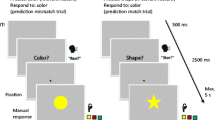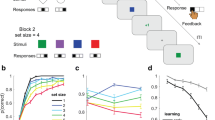Abstract
Decision makers in dynamic environments such as air traffic control, firefighting, and call center operations adapt in real-time using outcome feedback. Understanding this adaptation is important for influencing and improving the decisions made. Recently, stimulus-response (S-R) learning models have been proposed as explanations for decision makers' adaptation. S-R models hypothesize that decision makers choose an action option based on their anticipation of its success. Decision makers learn by accumulating evidence over action options and combining that evidence with prior expectations. This study examines a standard S-R model and a simple variation of this model, in which past experience may receive an extremely low weight, as explanations for decision makers' adaptation in an evolving Internet-based bargaining environment. In Experiment 1, decision makers are taught to predict behavior in a bargaining task that follows rules that may be the opposite of, congruent to, or unrelated to a second task in which they must choose the deal terms they will offer. Both models provide a good account of the prediction task. However, only the second model, in which decision makers heavily discount all but the most recent past experience, provides a good account of subsequent behavior in the second task. To test whether Experiment 1 artificially related choice behavior and prediction, a second experiment examines both models' predictions concerning the effects of bargaining experience on subsequent prediction. In this study, decision models where long-term experience plays a dominating role do not appear to provide adequate explanations of decision makers' adaptation to their opponent's changing response behavior.
Similar content being viewed by others
References
Anderson, J.R. (1993), Rules of the Mind. Lawrence Erlbaum Associates, Hillsdale, NJ.
Barto, A.G., R.S. Sutton and C.J.C.H. Watkins (1989), “Learning and Sequential Decision Making,” Tech. Rep. No. COINS 89-95, Amherst: University of Massachusetts.
Brehmer, B. (1990), “Strategies in Real-Time, Dynamic Decision Making,” in R. Hogarth (Ed.) Insights from Decision Making. University of Chicago Press, Chicago.
Brehmer, B. (1992), “Dynamic Decision Making: Human Control of Complex Systems,” Acta Psychologica, 81, 211–241.
Brehmer, B. (1995), “Feedback Delays in Complex Dynamic Decision Tasks,” in P. Frensch and J. Funke (Eds.) Complex Problem Solving: The European Perspective. Lawrence Erlbaum Associates, Hillsdale, NJ.
Carley, K.M. and J.-S. Lee (1998), “Dynamic Organizations: Organizational Adaptation in a Changing Environment,” in J. Baum (Ed.) Advances in StrategicManagement: Disciplinary Roots of StrategicManagement Research. JAI Press, London, Vol. 15, pp. 269–297.
Dienes, Z. and R. Fahey (1995), “Role of Specific Instances in Controlling a Dynamic System,” Journal of Experimental Psychology: Learning, Memory, and Cognition, 21(4), 1–15.
Dougherty, M.R.P., C.F. Gettys and E.E. Ogden (1999), “MINERVA-DM:AMemory Process Model for Judgments of Likelihood,” PsyRev, 106(1), 180–209.
Erev, I. (1998), “Signal Detection by Human Observers:ACutoff Reinforcement Learning Model of Categorization Decisions under Uncertainty,” Psychological Review, 105(2), 280–298.
Erev, I., Y. Bereby-Meyer and A.E. Roth (1999), “The Effect of Adding a Constant to All Payoffs: Experimental Investigation, and Implications for Reinforcement Learning Models,” Journal of Economic Behavior and Organization, 39, 111–128.
Erev, I. and A.E. Roth (1998), “Predicting How People Play Games: Reinforcement Learning in Experimental Games with Unique, Mixed Strategy Equilibria,” American Economic Review, 88(4), 848–881.
Fudenberg, D. and D.K. Levine (1998), The Theory of Learning in Games. The MIT Press, Cambridge, MA.
Gibson, F.P. (2000), “Feedback Delays: How can Decision Makers Learn Not to Buy a New Car Every Time the Garage is Empty?” Organizational Behavior and Human Decision Processes, 83(1), 141–166.
Gibson, F.P. and M. Fichman (1998), “Fear Appeals: What HappensWhen the Credit Collector Calls?” Unpublished Manuscript, in revision.
Gibson, F.P., M. Fichman and D.C. Plaut (1996), “Learning in Dynamic Decision Tasks—Credit Collections at Citicorp,” Technical Report, Citicorp Behavioral Sciences Research Council.
Gibson, F.P., M. Fichman and D.C. Plaut (1997), “Learning in Dynamic Decision Tasks: Computational Model and Empirical Evidence,” Organizational Behavior and Human Decision Processes, 71(1), 1–35.
Joslyn, S. and E. Hunt (1998), “Evaluating Individual Differences in Response to Time-Pressure Situations,” Journal of Experimental Psychology: Applied, 4(1), 16–43.
Kanfer, R. and P. Ackerman (1989), “Motivation and Cognitive Abilities: An Integrative/Aptitude-Treatment Interaction Approach to Skill Acquisition,” Journal of Applied Psychology, 74(4), 657–690.
Klein, G.A., J. Orasanu, R. Calderwood and C.E. Zsambok (Eds.) (1993), Decision Making in Action: Models and Methods. Ablex Publishing Corporation, Norwood, NJ.
Kleinmuntz, D.N. (1993), “Information Processing and Misperceptions of the Implications of Feedback in Dynamics Decision Making,” System Dynamic Reviews, 9(3), 223–237.
LeDoux, J. (1996), The Emotional Brain.Simon & Schuster, New York.
Levinthal, D. (1997), “Adaptation on Rugged Landscapes,” Management Science, 43, 934–950.
Logan, G.D. (1988), “Toward an Instance Theory of Automatization,” Psychological Review, 95(4), 492–527.
Logan, G.D. (1990), “Repetition Priming and Automaticity: Common Underlying Mechanisms?” Cognitive Psychology, 22, 1–35.
Logan, G.D. (1992), “Shapes of Reaction-Time Distributions and Shapes of Learning Curves: A Test of the Instance Theory of Automaticity,” Journal of Experimental Psychology: Learning, Memory, and Cognition, 18(5), 883–914.
McClelland, J.L., B.L. McNaughton and R.C. O'Reilly (1995), “Why There are Complementary Learning Systems in the Hippocampus and Neocortex: Insights from the Successes and Failures of Connectionist Models of Learning and Memory,” Psychological Review.
Naylor, J.C. and R.D. Clark (1968), “Intuitive Inference Strategies in Interval Learning Tasks as a Function of Validity Magnitude and Sign,” Organizational Behavior and Human Performance, 3, 378–399.
Paich, M. and J.D. Sterman (1993), “Boom, Bust, and Failures to Learn in Experimental Markets,” Management Science, 39(12), 1439–1458.
Rafaeli, A. and R.I. Sutton (1991), “Emotional Contrast Strategies as Means of Social Influence: Lessons from Criminal Interrogators and Bill Collectors,” Academy of Management Journal, 34(4), 749–775.
Raiffa, H. (1982), The Art and Science of Negotiation. Harvard University Press, Cambridge, MA.
Rapoport, A., I. Erev, E.V. Abraham and D.E. Olson (1997), “Randomization and Adaptive Learning in a Simplified Poker Game,” Organizational Behavior and Human Decision Processes, 69(1), 31–49.
Roth, A.E. and I. Erev (1995), “Learning in Extensive-Form Games: Experimental Data and Simple Dynamic Models in the Intermediate Term,” Games and Economic Behavior, 8, 164–212.
Stanley, W.B., R.C. Mathews, R.R. Buss and S. Kotler-Cope (1989), “Insight without Awareness: On the Interaction of Verbalization, Instruction, and Practice in a Simulated Process Control Task,” Quarterly Journal of Experimental Psychology, 41A(3), 553–577.
Sterman, J.D. (1989), “Misperceptions of Feedback in Dynamic Decision Making,” Organizational Behavior and Human Decision Processes, 43, 301–335.
Sterman, J.D. (1994), “Learning in and about Complex Systems,” System Dynamics Review, 10(2/3), 291–330.
Sutton, R.I. (1991), “Maintaining Norms about Expressed Emotions: The Case of Bill Collectors,” Administrative Science Quarterly, 36, 245–268.
Sutton, R.S. (1988), “Learning to Predict by the Method of Temporal Differences,” Machine Learning, 3, 9–44.
Author information
Authors and Affiliations
Rights and permissions
About this article
Cite this article
Gibson, F.P. Is It Better to Forget? Stimulus-Response, Prediction, and the Weight of Past Experience in a Fast-Paced Bargaining Task. Computational & Mathematical Organization Theory 8, 31–47 (2002). https://doi.org/10.1023/A:1015128203878
Issue Date:
DOI: https://doi.org/10.1023/A:1015128203878




